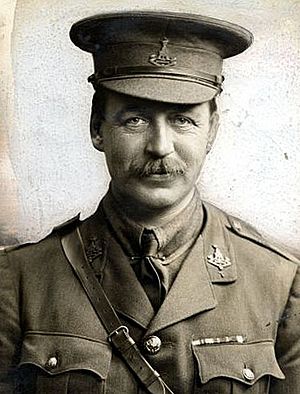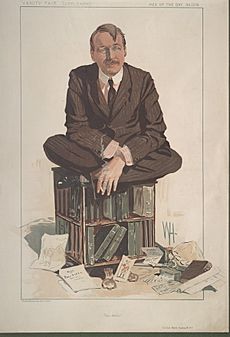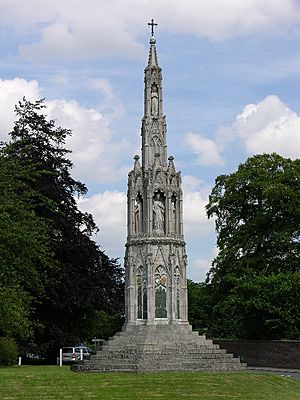Mark Sykes facts for kids
Quick facts for kids
Sir Mark Sykes, Bt
|
|
|---|---|

Sykes, c. 1918
|
|
| Born |
Tatton Benvenuto Mark Sykes
16 March 1879 Westminster, London, England
|
| Died | 16 February 1919 (aged 39) Hôtel Le Lotti, Paris, France
|
| Resting place | St Mary's Church, Sledmere, East Riding of Yorkshire, England |
| Occupation |
|
| Known for | Sykes–Picot Agreement, Conservative Party politician, diplomatic advisor, and traveller |
| Spouse(s) | Edith Gorst |
| Children | 6 |
| Parent(s) | Sir Tatton Sykes, 5th Baronet Christina Cavendish-Bentinck |
Sir Mark Sykes (born March 16, 1879 – died February 16, 1919) was an important English figure during the First World War. He was a traveler, a politician, and a special advisor on the Middle East.
He is best known for the Sykes–Picot Agreement. This was a secret plan made during the war to divide parts of the Ottoman Empire between Britain, France, and the Russian Empire. He also helped create the Balfour Declaration, which was a statement supporting a Jewish homeland in Palestine.
Contents
Early Life and Adventures
Mark Sykes was born in Westminster, London. He was the only child of Sir Tatton Sykes, a wealthy landowner. His parents had a difficult marriage and later separated.
Mark spent his time between his mother's home in London and his father's large estate, Sledmere House, in Yorkshire. He was raised as a Roman Catholic from a young age.
Sledmere House was a grand family home with large farms and a special place for breeding Arabian horses. Mark had a lot of freedom growing up. This helped him develop a great imagination.
He often traveled with his father to the Middle East, especially to the Ottoman Empire. These trips sparked his lifelong interest in the region.
Mark went to Beaumont College and Jesus College, Cambridge. He didn't finish his degree, but he was a very active writer. By age 25, he had published several books. These included travel stories like Dar-ul-Islam and Through Five Turkish Provinces. He also wrote The Caliphs' Last Heritage, which was a history and travelogue about the Middle East.
A friend, Aubrey Herbert, described Mark Sykes as a very lively person. He said Mark could turn any gathering into a party. He was full of new ideas and could make others excited about them. He was also good at drawing funny pictures and mimicking people.
Soldier, Traveler, and Politician
Mark Sykes was not content to just wait for his inheritance. In 1897, he joined the military. He served in the Second Boer War in South Africa for two years. He mostly did guard duty but also saw some fighting. After the war, he was promoted to captain.
He traveled a lot, especially in the Middle East. From 1905 to 1906, he worked at the British Embassy in Constantinople (now Istanbul). This further deepened his interest in Middle Eastern affairs.
Mark Sykes was an important figure in Yorkshire. He lived at Sledmere House, bred racehorses, and was a local judge. He also commanded a military unit. He married Edith Gorst, who was also a Catholic. They had a happy marriage and six children.
After two tries, Sykes was elected to Parliament in 1911. He represented Kingston upon Hull Central. He became friends with other important politicians. He was also friends with Aubrey Herbert, who was also interested in the Middle East. He knew Gertrude Bell and T. E. Lawrence, who were famous for their work with Arabs.
Sykes had a broad interest in different groups of people in the Middle East, including Armenians, Arabs, Jews, and Turks. He even had a special "Turkish Room" built in Sledmere House, designed by an Armenian artist.
The famous author H. G. Wells, who wrote Little Wars about miniature soldier games, even talked with Mark Sykes. They discussed how his war game could be used to train young army officers.
Working with Lord Kitchener
When the First World War began in 1914, Mark Sykes was a Lieutenant-Colonel. However, his special skills were needed in the War Office's intelligence department. He worked for Lord Kitchener, who was the Secretary of State for War.
Kitchener put Sykes on a committee that advised the government on Middle Eastern issues. Sykes quickly became a very influential expert on the region. He wrote papers encouraging Arab independence and revolt against the Ottoman Empire.
Sykes was one of the first to tell the Foreign Office that Turkey would join Germany in the war. Turkey officially joined in November 1914. Sykes believed that Turkey should no longer exist as an empire. He suggested ways to weaken it, like offering rewards for camels, telegraph insulators, and even Turkish army deserters.
In January 1916, the Foreign Office set up the Arab Bureau in Cairo, partly because of Sykes' ideas. Sykes also designed the flag of the Arab Revolt. This flag, with its green, red, black, and white colors, later inspired the flags of many modern Middle Eastern countries like Jordan, Iraq, and Palestine. These countries did not exist as separate nations before World War I.
In December 1916, Sykes was appointed to the War Cabinet Secretariat. He worked with the Supreme War Council in France.
Britain's Middle East Challenges
For a long time, Britain's policy was to support the Ottoman Empire (Turkey). This was to prevent Russia from expanding into the Mediterranean Sea and threatening Britain's important colony, India.
However, during World War I, the situation became more complicated. France wanted control over a large area called Greater Syria, which included Palestine. Italy also had claims in the Aegean Islands. Russia wanted control of the waterways from the Black Sea to the Aegean. Greece wanted old Byzantine territories. On top of this, Zionists hoped to create a Jewish homeland in Palestine.
Sykes traveled extensively to gather information for the British government. He went across Europe to Bulgaria, then by ship to Turkey, and then to Cairo, Egypt. From there, he went to India and back to Egypt. He reported his findings to the De Bunsen Committee.
He also met with Emir Abdullah and the Grand Sharif to discuss an Arab Revolt. Sykes worked to get support for this revolt. However, T. E. Lawrence (Lawrence of Arabia) had mixed feelings about Sykes. Lawrence thought Sykes was imaginative but sometimes unreliable in his ideas.
Sykes' main job was to reach an agreement with France, Britain's key ally in the war. His French counterpart was François Georges-Picot. They created the Sykes-Picot Agreement. Sykes later felt that France got a better deal in this agreement than Britain did.
The Balfour Declaration
On December 16, 1915, Sir Mark Sykes met with Prime Minister Asquith to discuss the Ottoman Empire. Sykes had become Britain's leading expert on Turkish affairs. He brought a map and a document outlining his ideas for Middle Eastern policy.
Sykes was concerned about the poor conditions he saw in cities like Aleppo and Damascus. He believed that the issue of Syria should be settled quickly with France.
Sykes played a role in promoting the Balfour Declaration, which was issued on November 2, 1917. He had visited Palestine and met with Chaim Weizmann, a leader of the Zionist movement. Sykes became a supporter of Zionism, with some conditions.
The Balfour Declaration stated that the British government "view with favour the establishment in Palestine of a national home for the Jewish people." It also said that nothing should be done to harm the rights of the non-Jewish communities already living in Palestine.
Towards the end of 1918, Sykes began to change some of his views on Zionism.
Death
Mark Sykes was in Paris in 1919 for the peace negotiations after World War I. He died in his hotel room on February 16, 1919, at the age of 39. He was a victim of the terrible Spanish flu pandemic that swept the world.
His body was brought back to his family home at Sledmere House in Yorkshire for burial. Even though he was a Roman Catholic, he was buried in the churchyard of the local Anglican church, St. Mary's, in Sledmere. A Zionist colleague, Nahum Sokolow, said that Sykes "fell as a hero at our side."
His son, Sir Richard Sykes, became the next Baronet. Another son, Christopher Sykes, became a well-known author. Mark Sykes' great-grandchildren include the fashion writer Plum Sykes.
Sledmere House is still owned by the Sykes family today.
Honours
During his service, Mark Sykes did not receive any British honours. However, he was made a Commander of the Order of St Stanislas by Tsarist Russia and held the Order of the Star of Romania.
Exhumation for Science
In 2007, 88 years after Sir Mark Sykes died, his living family members gave permission for his body to be dug up. This was for a scientific study led by a scientist named John Oxford. His remains were exhumed in September 2008.
Scientists were interested in his body because he had been buried in a lead-lined coffin. They hoped this would have preserved the Spanish flu virus particles inside him. Any samples taken would be used for research to help develop ways to fight future flu pandemics. The Spanish flu virus itself came from a bird flu virus called H1N1 that changed to infect humans.
There are only a few other samples of the Spanish flu virus in the world. Professor Oxford's team hoped to find a well-preserved body. However, the coffin had split open due to the weight of the soil, and the body was badly decomposed. Still, samples of lung and brain tissue were taken through the split in the coffin. The coffin stayed in the grave during this process. Afterwards, the grave was sealed again.
Legacy
Mark Sykes is featured in Balfour to Blair, a documentary about Britain's history in the Middle East.
The Sledmere Cross is a large stone monument that Sir Mark Sykes turned into a war memorial in 1919. He added brass portraits of his friends and local men who died in the war. He also added a brass portrait of himself dressed as a crusader.
Sykes also designed the Wagoners' Memorial. This memorial honors the men of the Wagoners Special Reserve, a military unit he created in 1912. It was made up of farm workers from Yorkshire who would drive horse-drawn wagons during the war.



